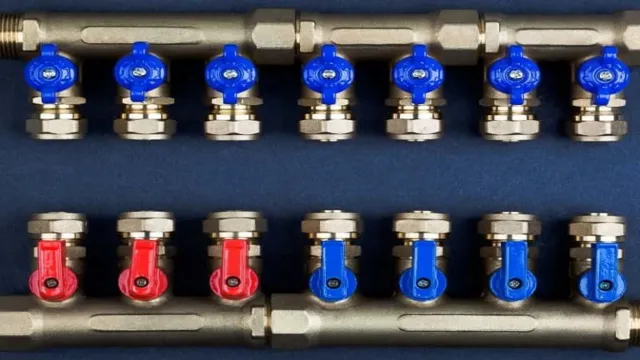Looking to install PEX piping in your home or business? It’s easy to see why this flexible and durable material is becoming the go-to choice for plumbing projects. However, with its rising popularity comes questions about PEX pipe pressure ratings. How much pressure can PEX piping handle? What factors affect its maximum pressure rating? In this blog post, we’ll tackle these questions and more, so you can feel confident in your PEX piping installation.
Think of us as your personal “pressure rating” guide!
What Is PEX Pipe?
PEX pipe is a popular type of plastic pipe used in plumbing and heating applications. One of the benefits of using PEX is its high level of flexibility, which allows for easy installation in tight spaces. Another benefit is its resistance to corrosion and scaling.
But how much psi can PEX handle? PEX pipe has a high burst strength, with most types rated between 160-200 psi at 73 degrees Fahrenheit. However, the max operating pressure for PEX depends on the temperature and pipe size, so it’s important to check the manufacturer’s specifications before use. In general, PEX can handle high pressures and is a reliable choice for residential and commercial plumbing and heating systems.
Definition
PEX pipe is a type of flexible plastic tubing used in plumbing and heating systems. It stands for Cross-linked Polyethylene, which means that the polymer molecules are chemically bonded together to form a stronger and more durable material. PEX piping is often used as an alternative to traditional copper or PVC pipes as it is easier to install, more affordable, and resistant to freeze damage.
It can also be used for both hot and cold water supply lines and is highly flexible, making it easy to bend around corners and obstacles. PEX pipe is a reliable and long-lasting plumbing solution that offers many advantages over traditional materials.

Advantages
PEX pipe is a type of plastic piping that has become increasingly popular in recent years due to its many advantages over traditional metal and PVC pipes. One major advantage of PEX pipe is its flexibility, which allows it to bend and maneuver around corners without the need for fittings or joints. This can save both time and money during installation.
Another advantage is its durability – PEX pipe is resistant to corrosion, scale, and chlorine, which can prolong its lifespan and reduce the need for repairs. Additionally, PEX pipe is quieter than metal pipes, which can be beneficial in residential settings. Plus, it is more energy-efficient due to its insulation properties, which can help lower heating and cooling costs.
Overall, PEX pipe is a reliable and versatile option for both residential and commercial plumbing applications.
How Much Pressure Can PEX Pipe Handle?
PEX pipes are able to handle high levels of pressure compared to other plumbing materials. They are designed to withstand up to 200 psi, with some brands able to handle even more. However, it’s important to note that the pressure rating of PEX pipes is influenced by factors such as the diameter of the pipe, temperature, and the quality of the fittings used.
It’s also important to ensure that the pipes are installed and secured properly to prevent bursting or leaks. PEX pipes are a durable and reliable choice for plumbing systems, providing homeowners with peace of mind knowing their pipes can handle high pressure. If you are unsure about the pressure level needed for your specific plumbing needs, it’s recommended to consult with a licensed plumber who can provide more information.
PEX Pipe Pressure Ratings
PEX pipe is becoming more popular in residential and commercial plumbing systems due to its durability, flexibility, and overall versatility, but just how much pressure can PEX pipe handle? The answer is that it all depends on the type of PEX pipe and the method of installation. For instance, PEX-A has a higher pressure rating than PEX-B and PEX-C. PEX pipes used for heating applications are also designed to withstand higher pressures than those used for cold water purposes.
The average pressure rating for PEX pipes ranges from 160 to 200 psi at standard operating temperatures, making it an excellent choice for most plumbing applications. However, it is essential to ensure that the installation of your PEX pipes follows the proper procedures and that the materials used are compatible with the operating conditions. If installed correctly, PEX pipes can be a reliable and long-lasting alternative to traditional plumbing systems.
Factors Affecting PEX Pipe Pressure Ratings
PEX pipe pressure ratings Have you ever wondered how much pressure PEX pipes can handle? PEX pipes have become increasingly popular in recent years due to their versatility and cost-effectiveness. However, PEX pipe pressure ratings vary depending on several factors. One of the significant factors affecting PEX pipe pressure ratings is the size of the pipe.
Smaller pipes can handle less pressure compared to larger pipes. Another critical factor is the temperature of the water flowing through the PEX pipes. High-temperature water can cause the PEX to expand, leading to a decrease in the pressure handling ability of the pipes.
Other factors affecting PEX pipe pressure ratings include the quality of the installation, the type of fittings used, and the chemical composition of the water. It’s important to ensure that you understand the PEX pipe pressure ratings needed for your specific application. Choosing the right pipe size and using the appropriate fittings in your installation can help ensure that your PEX pipes can handle the pressure required for your system.
Comparing PEX Pipe to Other Plumbing Materials
When it comes to plumbing materials, PEX pipe stands out for its ability to handle high levels of pressure. In fact, PEX has a higher burst pressure rating than both copper and PVC pipes. This means that it can withstand sudden and intense increases in water pressure without rupturing or bursting.
PEX pipe also has a high resistance to freeze damage, making it ideal for colder climates. Its flexibility allows for easy installation and manipulation, reducing the need for fittings and joints that can weaken the plumbing system over time. Overall, PEX pipe is a durable and reliable option for homeowners looking for a long-lasting plumbing solution that can handle high levels of pressure without sacrificing performance.
Choosing the Right PEX Pipe for Your Needs
When it comes to choosing the right PEX pipe for your needs, it’s important to consider the amount of pressure your system will be under. Generally speaking, PEX pipes can handle a range of pressures, with most able to withstand a minimum of 100 psi. However, this can vary depending on the specific type and manufacturer of the pipe you choose.
It’s important to do your research and understand the maximum pressure rating of the PEX pipe you’re considering, as well as any other factors that may impact its durability and longevity. By choosing a high-quality PEX pipe that’s designed to handle the pressure requirements of your system, you can ensure reliable performance and avoid the risk of burst pipes and other issues down the line.
Types of PEX Pipe
PEX pipe PEX pipes come in three different types: PEX-A, PEX-B, and PEX-C. Each type offers distinct advantages and disadvantages that should be considered when choosing the right one for your needs. PEX-A has the highest flexibility and is best for jobs that require minimal connections as it can be bent and curved without kinking.
PEX-B has a higher burst pressure than PEX-A but is less flexible, making it ideal for jobs that require more connections. PEX-C has the lowest burst pressure but is the least expensive option. It is commonly used in residential plumbing applications that don’t require as much pressure.
When deciding which type of PEX pipe to use, consider the specific needs of your project and consult with a professional if necessary.
Considerations for Choosing PEX Pipe
Choosing the right PEX pipe for your needs can be a daunting task. It’s important to consider certain factors before making your final decision. One of the most important considerations is the type of PEX pipe you need, whether it’s PEX-A, PEX-B, or PEX-C.
Each type has its own advantages and disadvantages, so it’s important to know which one is best for your specific needs. Another important factor to consider is the size of your PEX pipe. The size of the pipe will determine how much water flow you have and the pressure you need.
Finally, it’s important to consider the fittings you want to use with your PEX pipe. There are several types of fittings that work better with different types of PEX pipes, so it’s important to make sure you choose the right fittings for your chosen PEX pipe. Overall, choosing the right PEX pipe is crucial for your plumbing system, so take your time and consider all factors before making your final decision.
Conclusion
In conclusion, the answer to how much psi PEX can handle is like asking how long a piece of string is – it depends. Different types of PEX have different pressure ratings, and factors such as temperature, water flow, and installation method can also impact its durability. But one thing is for sure, PEX is a versatile and durable option for plumbing applications, so you can rest assured that it can handle the pressure – whatever that may be!”
FAQs
1. What is PEX piping and how does it compare to other types of plumbing materials in terms of PSI capability?
PEX piping is a type of cross-linked polyethylene tubing that is commonly used in plumbing systems. When it comes to PSI capability, PEX piping is known to be highly resistant to pressure, with a typical range of 80-200 PSI depending on the manufacturer and the style of tubing. This makes it a reliable option for both residential and commercial plumbing applications.
2. Can PEX piping be used for high-pressure applications in industrial settings?
Yes, PEX piping can be used for high-pressure applications in industrial settings, provided that the tubing is rated for the specific pressure and temperature conditions it will be exposed to. It’s important to note that certain types of PEX piping may be better suited for higher-pressure applications than others, so it’s important to consult with a professional plumber or engineer to ensure that the right materials are being used.
3. Are there any limitations to the PSI capability of PEX piping?
While PEX piping is generally known for its high resistance to pressure, there are certain factors that can impact its effectiveness in this regard. For example, exposure to extreme temperatures or corrosive chemicals may cause the tubing to degrade or weaken over time, leading to a reduction in its PSI capability. Additionally, improper installation or use of incompatible fittings or connectors can compromise the overall strength and durability of the plumbing system.
4. How does the diameter of PEX tubing impact its PSI capability?
The diameter of PEX tubing can impact its PSI capability, with larger-diameter tubing generally being able to handle higher pressures than smaller-diameter tubing. However, it’s important to note that other factors such as the quality of the tubing materials, installation method, and system design can also influence the overall PSI capability of the plumbing system.
5. What is the recommended PSI range for residential PEX plumbing systems?
According to industry standards, the recommended PSI range for residential PEX plumbing systems is between 40 and 80 PSI. This range is considered safe and effective for most household applications, and can help to ensure the longevity and reliability of the plumbing system. It’s important to monitor the pressure in your plumbing system regularly and make adjustments as needed to maintain optimal performance.






